|
Sihanoukville: Sights
and Landmarks
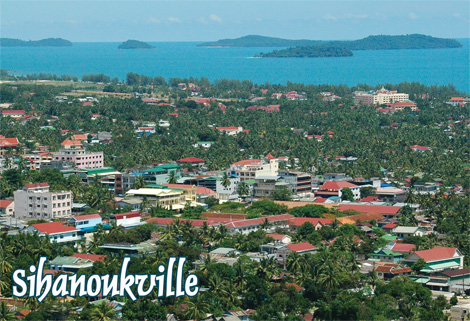
|
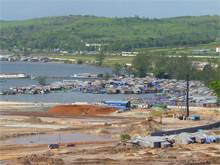 Fishing Port Fishing Port
The fishing port (Kampong Pier Nup Lok) sits about 2 km north of the main port on Hun Sen Beach Drive
on the other side of the port shelter area near the quay. Fishing boats
and other small local boats dock here instead of the main port area. A
small village has grown around the fishing port - a ramshackle
collection of shops and houses clustered near the docks and stretching
along Hun Sen Drive in both directions. The docks wooden dock and
surrounding village are a whirl of color and local activity - chaotic,
dirty, pungent and potentially photogenic. Fishing boats stream out of
this port every night just before sunset - a beautiful sight, especially
from Victory beach.
|
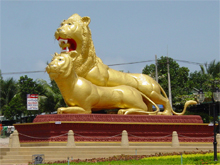 Golden Lions Monument
The Golden Lions Monument (Vimean Tao Meas) is a prominent
Sihanoukville landmark
located in the middle of the traffic circle between Sokha and Ochheuteal
beaches. The monument was constructed in 1996 and I've heard several
different versions of what it is supposed to represent. The traffic circle is
surrounded by Cambodian restaurants and karaoke places and the gardens
around the monument have become a popular evening hangout for the
locals, particularly local teens. The road to Serendipity beach
runs off of the Golden Lions Traffic Circle. Golden Lions Monument
The Golden Lions Monument (Vimean Tao Meas) is a prominent
Sihanoukville landmark
located in the middle of the traffic circle between Sokha and Ochheuteal
beaches. The monument was constructed in 1996 and I've heard several
different versions of what it is supposed to represent. The traffic circle is
surrounded by Cambodian restaurants and karaoke places and the gardens
around the monument have become a popular evening hangout for the
locals, particularly local teens. The road to Serendipity beach
runs off of the Golden Lions Traffic Circle. |
|
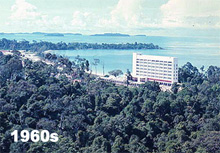 Independence Hotel Independence Hotel
The seven-storey Independence Hotel on the point between Victory and Independence Beaches was
Sihanoukville’s premiere accommodation in the 1960’s. The port had been completed in
1960 and Sihanoukville was quickly becoming a popular beach
destination, attracting a growing stream tourists and
weekenders from Phnom Penh. It was the heyday of
Sihanoukville’s early development. Villas were popping up on
Ochheuteal and the time was ripe for the addition of upscale
hotel facilities.
The Independence Hotel was constructed in
1963/64 at a cost of 30,000,000 Riel, though it was not inaugurated
until November 13, 1968. The hotel was
designed by French
architect M. Mondet of Leroy & Mondet, who were also responsible
for several other 1950s/60s structures in Cambodia. The hotel was
originally constructed seven storeys tall, with 45 rooms
total, uniquely designed with all rooms situated on only one
side of the hotel so that they all faced the ocean.
After the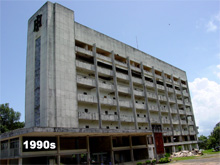 hotels completion an additional 50 tourist class bungalows
were added to the grounds to accommodate more guests. Interior
decoration of parts of the hotel was done by HE Norodom Sihanouk himself, who
was Prime Minister and former King of Cambodia at the time. HE Norodom
Sihanouk also designed the Promenade des Anglais - a garden and walkway
at the base of the rocky headland that borders the northern end of
Independence Beach. Color schemes of ochres, oranges, red and black,
mint green, reds and chartreuse were used, adding to the liveliness and
holiday spirit of
interior design.
hotels completion an additional 50 tourist class bungalows
were added to the grounds to accommodate more guests. Interior
decoration of parts of the hotel was done by HE Norodom Sihanouk himself, who
was Prime Minister and former King of Cambodia at the time. HE Norodom
Sihanouk also designed the Promenade des Anglais - a garden and walkway
at the base of the rocky headland that borders the northern end of
Independence Beach. Color schemes of ochres, oranges, red and black,
mint green, reds and chartreuse were used, adding to the liveliness and
holiday spirit of
interior design.
The Independence Hotel
was abandoned as a hotel when the Khmer Rouge seized power in 1975.
After the fall of the Khmer Rouge in 1979 the hotel was taken over by
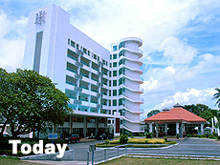 squatters
who occasionally opened some rooms to paying guests. During the 1980s
the locals started referring to it as 'Hotel Pram-Pul
Jawn,' which means '7-storey hotel,' and the name
stuck. Even today many locals know it only by that name.
Following the hotel, the nearby Independence Beach has also
become known as 'Chhne
Samot Hotel Pram-Pul Jawn,' i.e. '7-Storey Hotel
Beach.' The Independence opened briefly during UNTAC’s (United
Nations Transitional Authority in Cambodia) stay in the early 1990’s
in order to accommodate the influx of
foreign visitors and then was abandoned again in 1993. In
2004 renovation work began on the hotel. Completed two year
later the
Independence Hotel
has been fully and carefully restored to its former
opulence and reopened
as modern upscale accommodation. squatters
who occasionally opened some rooms to paying guests. During the 1980s
the locals started referring to it as 'Hotel Pram-Pul
Jawn,' which means '7-storey hotel,' and the name
stuck. Even today many locals know it only by that name.
Following the hotel, the nearby Independence Beach has also
become known as 'Chhne
Samot Hotel Pram-Pul Jawn,' i.e. '7-Storey Hotel
Beach.' The Independence opened briefly during UNTAC’s (United
Nations Transitional Authority in Cambodia) stay in the early 1990’s
in order to accommodate the influx of
foreign visitors and then was abandoned again in 1993. In
2004 renovation work began on the hotel. Completed two year
later the
Independence Hotel
has been fully and carefully restored to its former
opulence and reopened
as modern upscale accommodation.
www.independencehotel.net
|
|
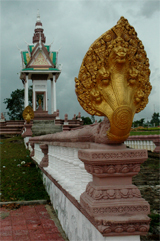 Independence Square Independence Square
The Independence Square consists of an open meeting hall
on Ekareach Street (Independence Street), and across
the street a small park containing a small shrine and the Independence Monument (Vimean Ekareach),
which is a monument to Cambodia's independence from foreign rule and to
Cambodia's war dead. Note the urn-like structure at the center of
the monument. The Independence Monument was constructed in in 1985. Most
of the trees in the park have been recently felled and the park is
undergoing a general renovation. Ceremonies are held at the park on January 7th
and some other national holidays. Located at the intersection of
Ekareach Street (main street) and Mittapheap Kampuchea Soviet Street
(Cambodia/Soviet Friendship Street.)
|
|
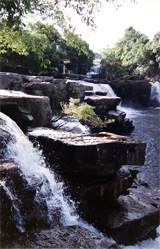 Kbal
Chhay Waterfalls Kbal
Chhay Waterfalls
The Kbal
Chhay Waterfalls are a series of
waterfalls (3-5 meters) and chutes on the Prek Tuk Sap River, located
about 10km north of town. During the dry season (November-June), the
falls can be little more than a trickle, but the wet season falls can be
quite powerful. The area is slowly being developed and there are now
drink stands, food stalls and covered picnic areas available. Lots of
local picnickers crowd the area on the weekends. A favorite for local
families and teens. It’s about a 30-minute ride from downtown
Sihanoukville to the falls. Take Route 4 north to the ‘Kbal Chhay’ sign
near mile marker 217, about 1km north of the anchor and globe monument.
|
|
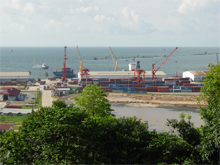 Port of Sihanoukville Port of Sihanoukville
The town of Sihanoukville exists due to the construction of the Port of
Sihanoukville. Prior to 1954, Cambodia maintained international sea
trade via the Mekong. But the demise of French Indochina in the early
1950s meant the Mekong delta reverted to the control of
Vietnam and, lacking a deep water port, Cambodia was cut off from
the ocean. Seeking unfettered access to the ocean, plans were made to
construct a new deep water ocean port. The Kampong Som area (later to be renamed
Sihanoukville) was selected over other areas such as Ream and Kampot for water depth and
ease of access. The port facilities and National Route #4 connecting the port to
Phnom Penh (known at the time as the Khmer-American Friendship Highway) were constructed from 1955-60. France contributed the bulk of
the funds to construct the port and the USA contributed the funds to build the road.
The new Port of Sihanoukville was inaugurated by French Minister of
State Louis Jacquinot in April 1960. The port waters are 11-13 meters deep except for an 8-9
meter point in the channel near Koh Pos. The older quay can be seen from Victory Beach jutting 290
meters into the ocean. The northern section consists of a 350 meters quay and 3117
meters of breakwater.
Large ships general approach from the west. Previously they approached
from the southwest between Koh Pos Island and the mainland, but the
construction of the new bridge has cut of that approach.
http://www.pas.gov.kh/
(Port of Sihanoukville website)
|
|
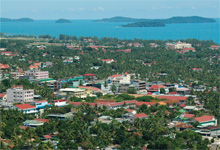 Sihanoukville Mountain Sihanoukville Mountain
This 132 meter peak just behind the main town area offers a spectacular view of the city, the islands and the beaches from Otres to the port. Take
the hill road from the back of town up the hill to the main
road. Turn left and follow the road to the top of the hill
about 200 meters past Wat Leu. Or alternatively, take Route 4 about 2.5km north of town. Make a right turn at the brewery and follow the road up the hill, about 200m past the
Wat Leu. Walk out on the rocks. It is an excellent spot to
view sunset though the security is sometime questionable
after dark. Ask you guesthouse about the current situation.
|
|
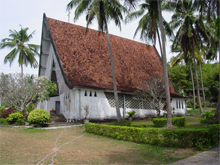 St. Michael’s Church St. Michael’s Church
St. Michael's is the only Catholic Church in
Sihanoukville and one of the town's original buildings. Only two of
Cambodia's 73 churches survived the Khmer Rouge period of the late
1970s: the Carmelite Chapel in Phnom Penh and St Michael's in
Sihanoukville.
According to official records the church was inaugurated in 1962,
but was reportedly constructed in 1960. The church was designed by
French Catholic priest Father Ahadobery with the assistance of Cambodian
architect Vann Molyvann and constructed on land donated by HE Norodom
Sihanouk. St Michael is the patron saint of sailors and the churches
architecture also reflects the seafaring theme of this port town church.
Note the ‘ship’s sail’ brick latticework at the front of the church
building and the boat shaped latticework on the sides. It served local,
mostly ethnic Vietnamese) Catholics continuously until 1975. (Even after
centuries of missionary work, the Catholic Church has had very little
luck converting Khmers in Cambodia to Catholicism, capturing less than
1% of the population. On the other hand, more than 15% of the population
of Vietnam is Catholic, most of them in the south. Likewise, a
significant percentage of ethnic Vietnamese in Cambodia are Catholic.)
Under the Khmer Rouge from 1975-79, religion of all sort was banned, and
the church was used as a jail and a barn. After the fall of the KR in
1979 the church saw very little ascent in its station, still being used as storage
building. St. Michael's was not reopened as a church until 1993.
Today is
active and serving 50+ families, many of whom are Vietnamese. It is
located at the base of Sihanoukville Mountain, just off the corner of Boray Kamakor and Kampuchea-Soviet Mittapheap Streets.
http://www.catholiccambodia.org/en/mass/mass.php (Website of the
Catholic Church in Cambodia)
|
|
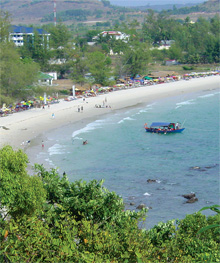 The
Beaches The
Beaches
Sihanoukville town sits in the center of a small peninsula
that juts into the warm waters of the Gulf of Thailand.
Several beaches of fine pearl-white sand, line the shore
around the peninsula, all easily accessible from the town.
The main beaches are lined with little thatch roofed beach
bars and seafood shacks offering cold drinks, beach
umbrellas and chairs, seafood BBQ, evening parties and water
sports.
Ochheuteal and Serendipity Beaches are the most popular
and the busiest with plenty of nearby hotels, guesthouses,
bars and restaurants. On the other side of town,
Victory
Beach at the base of Weather Station Hill (aka Victory
Hill) is also popular but not as busy, offering a somewhat
more tranquil atmosphere. Budget bungalows and guesthouses
sit on the side of the hill and the beach sports seafood
shacks, chairs, umbrellas and even a nightclub.
Otres Beach
is similar to Ochheuteal but far less touristed and has a
much more relaxed, out of the way feel. Currently there are
plenty of little seafood shacks and bars and a few places
offering beach bungalows. For more beaches and much more
details see the
beaches
page.
|
|
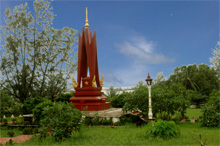 Victory
Monument Victory
Monument
Victory Monument on the road between Weather Station Hill
(Victory Hill) and Victory Beach, was built in 1985 to symbolize Cambodia’s friendship with Vietnam and the Vietnamese-assisted victory over the Khmer Rouge in Cambodia.
It is also known as a Vietnam/Cambodia Friendship Monument. One of these monuments can be found in almost every major town in Cambodia.
The nearby beaches and general area has become know after the monument -
the
Victory Beaches and
the Victory area.
|
|
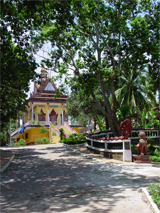 Wat Chotynieng Wat Chotynieng
Wat Chotynieng (aka Wat Leu, ‘upper wat’) overlooks town from the top of Sihanoukville Mountain.
From downtown you can see the wat atop the hill near the antennas. You
can also see a Chinese style graveyard on the side of the hill under the
wat. Paintings in the vihear at the pagoda depict the life of Buddha. At the rear are portraits of the founder, Prince Junot, and Lok Om (left), the leader of the Buddhist community in this area until his death in 1999. In front of the chapel is a statue of Lok Om, erected in 1996.
|
|
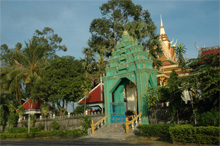 Wat Utynieng Wat Utynieng
Wat Utynieng (aka Wat Krom meaning ‘lower wat’) sits on a small hill on Santipheap Street overlooking the ocean.
It is one of the three most important wats in the
Sihanoukville town area, the other two being Wat Leu on the
hill behind town the and the wat near Otres beach. Very uniquely, this wat contains a building dedicated solely to Ya-Mao, a local
deity.
|
|
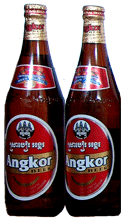 Cambrew Brewery Cambrew Brewery
Located just north of Sihanoukville, Cambrew Ltd. is Cambodia's
one and only
brewery, producing Angkor, Bayon, Angkor Extra Stout, Black
Panther and Klang beers, as well as some Pepsi products.
Angkor Beer is Cambodia's national beer, sporting a logo of a three towered
silhouette
of Angkor Wat. All the Cambrew beers are available in Cambodia and some
are available overseas as well, including Angkor Beer.
The brewery was originally constructed in 1966
under the name SKD Brewery (Societie des Khmere Distilleries)
(officially inaugurated November 13, 1968) and was operated by the government from 1967-1975 brewing
Angkor and Bayon beers as well as other bottled beverages.
The brewery building was designed by famed Cambodia architect Vann
Molyvann during the 'golden period' of New-Khmer Architecture. The main
office building follows the distinctive 'dong raik' architectural design
form in which the
upper floor overhangs the ground floor by several meters, highlighted
and reflected in
the shape of the distinctive triangle supports in the facade.
Sihanoukville was chosen as the site for the
brewery for the quality of the local water which supposedly had
the ideal mineral content for brewing beer. The choice of Sihanoukville
was not without controversy at the time due to the distance from the bottle
manufacturing plant near Phnom Penh. After 8 years of operation, production
at the brewery shut down with fall of
Cambodia to the Khmer Rouge in 1975 and the facilities remained idol for more than a
decade. Some references state that the brewery was abandoned until 1998,
but this is incorrect. The brewery was in full operation in 1995 when I
toured the the facilities and interviewed the manager. According to that
interview, with the aid of foreign investment, the brewery was refurbished and production was reinstituted in 1991.
The brewery has operated continuously since that time, occasionally
adding new products to its collection of beers.
Located 3 km north of
Sihanoukville on National Route #4.
Open house for tourists every
Wednesday from 3:00PM-5:00PM.
www.angkorbeer.com.kh (Cambrew Ltd.)
|
|
Iber Bilkhalifah Mosque
is utilized by the local Cham community. It’s almost hidden at the top of the first hill west of town center near the Red Snapper. Closed and locked most of the time. |
|
Stung Hau Town District seat/small fishing town about 23km north on Hun Sen Beach Drive. Boat building, lots of fresh fish, no tourist facilities. Worth a half-day trip for look at a bit of small town Cambodia. Pleasant road trip along the ocean to get there. |
|

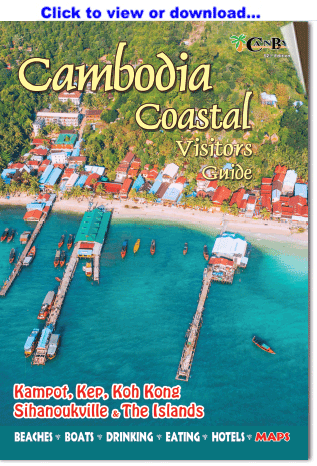
|





